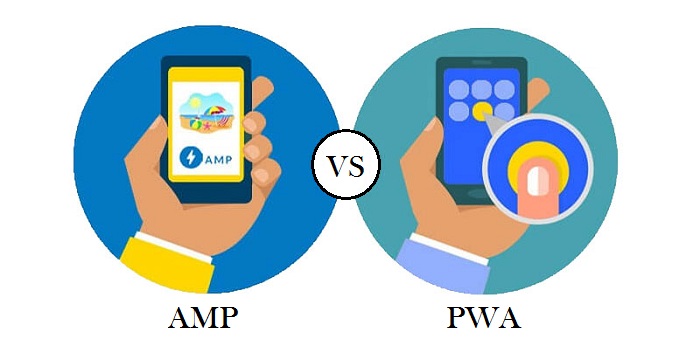What is the difference between AMP and PWA?

With the rapid growth of technology and popularization of mobile applications, life has become much swifter and simpler. The technology has made it easy to access any information faster especially through mobile phones. Through this article, I will tell you about two technologies i.e. AMP & PWA that will enhance the mobile user’s experience while accessing applications and website.
AMP vs. PWA: An Introduction
AMP stands for Accelerated Mobile Pages. It is a platform which can be used to increase the website pages speed on mobile phones. AMP is good for blog post and pages of the website where you share your content and information. Through AMP faster pages get more preference over slower pages. Whereas,
PWA stands for Progressive Web Apps. PWA is web pages or web apps that look like a mobile app and provides an app-like experience on the web. It enhances to work offline or on poor quality networks. It uses the collection of design concepts, the latest features that modern browser supports. Almost all big e-commerce websites have PWAs.
Now, let’s try to understand more about AMP & PWA through their features.
Features of AMP & PWA
– AMP
- AMP reduces the time taken for loading the pages and helps in loading website faster.
- Helps in boosting SEO rank and also enhances mobile SEO and improves keyword rating on mobile devices.
- It controls website publishers over visual effects and business designs.
– PWA
- PWA’s best feature is to work on offline mode or on poor networks.
- It’s progressive in nature as it can work for all users regardless of their browser choice.
- Ensure safe content and prevent spying and it’s compatible for any device.
- PWA does not require any kind of installation and can be shared easily.
Let’s have a look at some pros and cons of AMP and PWA!
Pros and Cons of AMP!
The Pros,
- Useful for websites that are content-based such as news publishers.
- Webpages get easily cached and loaded and all ad formats are supported.
- Enhances and deepens engagement factor
- Publishers of the website have full control over both the business and visual designs.
The Cons,
- Not suitable for big e-commerce sites.
- Cannot help you in enhancing search engine ranking.
- Not possible to track user’s activity on AMP.
- Load functionality is not good as images are done with the ineffective approach you can’t download without scrolling down to them.
Pros and Cons of PWA
The Pros,
- No installation or app updates required and no need for the separate codebase.
- You can add it to home screen icon and use it offline too.
- Will give you fast and quick loading irrespective of network quality.
- Secure, responsive, progressive, linkable, shareable and gives you fresh content always.
The Cons,
- Being a new technology, all browsers don’t support it fully.
- Its limited hardware as you can’t access easily.
- PWA doesn’t have access to a user’s personal information such as contact list, calls and messages thereby it limits your connection with users.
By now I hope you have clearly understood the difference between AMP & PWA. As you can see that both these tools go hand in hand and you can use them to improve the speed of your website and thereby reduce the loading time. As the reduction in loading time means a reduction in waiting, therefore, proves highly beneficial for both your business and customers. They also help you in ensuring the safety of mobile searches. But if you’re still confused then you can read further.
Which one is better to use: AMP or PWA?
First of all, it’s important to know the difference between the two. Both AMP & PWA are significant for the owner of the ‘https’ website. If you have a website which is content-based then you should go for AMP as it will let users access the content that matters to them.
And if you have an e-commerce website then you should take PWA into consideration as it will improve the user’s experience and keep them engaged. For PWA, the website should be highly dynamic and focus less on faster content loading. Therefore both AMP & PWA can work simultaneously as both have the capacity to work nicely and efficiently. There are many who may tell you that PWA is better than AMP but I recommend you not to ignore any of the ones. Because there is millions of website visited by users every day and they store all apps in their mobile phones.
That’s why it’s totally up to the user’s needs and requirements to select the one which is more suitable for them. But it’s an advice to you to maintain an excellent balance while investing in AMP & PWA.
For more updates get in touch with us, till then keep reading.


